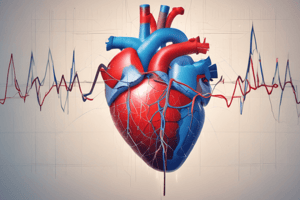Podcast
Questions and Answers
The PR segment represents electrical conduction through the ______
The PR segment represents electrical conduction through the ______
- Sinoatrial (SA) node and atria
- Atrioventricular (AV) node and bundle of His (correct)
- Bundle of His and ventricles
- Atria and atrioventricular (AV) node
Blood entering the right atrium is ______
Blood entering the right atrium is ______
- Deoxygenated (correct)
- Thin
- Thick
- Oxygenated
Which of the following can EKG graph paper be used to measure?
Which of the following can EKG graph paper be used to measure?
- Amplitude of electrical activity (correct)
- Blood oxygen level
- Respiratory rate
- Blood pressure
An axillary temperature is typically ______
An axillary temperature is typically ______
AHA is the abbreviation for ______
AHA is the abbreviation for ______
What occurs during systolic pressure?
What occurs during systolic pressure?
Where is lead V2 of an ECG typically placed?
Where is lead V2 of an ECG typically placed?
Where do premature ventricular contractions (PVCs) originate?
Where do premature ventricular contractions (PVCs) originate?
What is the name of the line connecting a T wave and the next P wave on an ECG?
What is the name of the line connecting a T wave and the next P wave on an ECG?
What is the function of the pericardium?
What is the function of the pericardium?
What does the T wave represent?
What does the T wave represent?
What is syncope?
What is syncope?
Which body system sends, receives, and interprets information and coordinates internal body functions?
Which body system sends, receives, and interprets information and coordinates internal body functions?
What is the term for the rate at which the ventricles contract?
What is the term for the rate at which the ventricles contract?
What is the layer of tissue that lines the heart's inner chambers called?
What is the layer of tissue that lines the heart's inner chambers called?
Which description fits the outer layer of the heart wall?
Which description fits the outer layer of the heart wall?
In first-degree AV block, how would you describe the PR interval?
In first-degree AV block, how would you describe the PR interval?
What is another name for the Bicuspid valve?
What is another name for the Bicuspid valve?
What structure surrounds and encloses the heart?
What structure surrounds and encloses the heart?
What is described as tachycardia?
What is described as tachycardia?
Which statement accurately describes the space in the chest between the lungs?
Which statement accurately describes the space in the chest between the lungs?
What is the innermost lining of the heart called?
What is the innermost lining of the heart called?
What is the primary purpose of a Holter monitor?
What is the primary purpose of a Holter monitor?
Which of the following describes characteristics of atrial tachycardia?
Which of the following describes characteristics of atrial tachycardia?
Swelling due to fluid buildup in the tissues is called what?
Swelling due to fluid buildup in the tissues is called what?
Which term refers to an abnormal accumulation of fluid in the body's tissues?
Which term refers to an abnormal accumulation of fluid in the body's tissues?
What is the medical term for swelling caused by fluid retention?
What is the medical term for swelling caused by fluid retention?
Which of the following conditions is characterized by swelling from fluid buildup in tissues?
Which of the following conditions is characterized by swelling from fluid buildup in tissues?
Which condition is primarily a result of excess fluid in the tissues leading to swelling?
Which condition is primarily a result of excess fluid in the tissues leading to swelling?
Flashcards
PR segment conduction
PR segment conduction
Electrical conduction through the atrioventricular (AV) node and bundle of His.
Right Atrium Blood
Right Atrium Blood
Deoxygenated blood enters the right atrium.
EKG graph paper measures
EKG graph paper measures
Amplitude of electrical activity in the heart.
Axillary temperature vs Oral
Axillary temperature vs Oral
Signup and view all the flashcards
AHA abbreviation
AHA abbreviation
Signup and view all the flashcards
Systolic pressure
Systolic pressure
Signup and view all the flashcards
Lead V2 placement
Lead V2 placement
Signup and view all the flashcards
PVC origin
PVC origin
Signup and view all the flashcards
Isoelectric line
Isoelectric line
Signup and view all the flashcards
Pericardium
Pericardium
Signup and view all the flashcards
Bicuspid valve
Bicuspid valve
Signup and view all the flashcards
Tachycardia
Tachycardia
Signup and view all the flashcards
Endocardium
Endocardium
Signup and view all the flashcards
Holter monitor
Holter monitor
Signup and view all the flashcards
Atrial tachycardia
Atrial tachycardia
Signup and view all the flashcards
T wave
T wave
Signup and view all the flashcards
Ventricular rate
Ventricular rate
Signup and view all the flashcards
Syncope
Syncope
Signup and view all the flashcards
P wave
P wave
Signup and view all the flashcards
Nervous system role
Nervous system role
Signup and view all the flashcards
Heart's Inner Lining
Heart's Inner Lining
Signup and view all the flashcards
Heart's Outer Layer
Heart's Outer Layer
Signup and view all the flashcards
First Degree AV Block
First Degree AV Block
Signup and view all the flashcards
PR Interval
PR Interval
Signup and view all the flashcards
Edema
Edema
Signup and view all the flashcards
What causes edema?
What causes edema?
Signup and view all the flashcards
Fluid retention
Fluid retention
Signup and view all the flashcards
How to reduce edema?
How to reduce edema?
Signup and view all the flashcards
Signs of edema
Signs of edema
Signup and view all the flashcards




